A few days I presented a webinar on snow leopard conservation which was watched live by 995 people, which was the second highest number, second to Pebble Redux, in the entire “Natural Habitat’s Daily Dose of Nature” webinar series. You can watch the recorded version here-
I have gotten lots of questions from viewers, as I couldn’t cover all of snow leopard topics and information in only an hour. I figured I would answer them all on here, as they were all great questions, and folks can ask further questions in the comments.
Questions-
How many snow leopards are collared and being tracked? There has been a handful of snow leopards collared in Ladakh over the last few years, and this has provided some really groundbreaking information on their home ranges and behavior, but these exact locations are not available to the public for anti-poaching reasons. This is pretty standard across their vast range, but there have been several projects in Mongolia, China and other regions, but limited. The use of camera traps for this information is growing, as it is less invasive to the animals. Microsoft Artificial Intelligence technology has allowed for much more efficient methods of keeping track of snow leopard movement and population estimates.
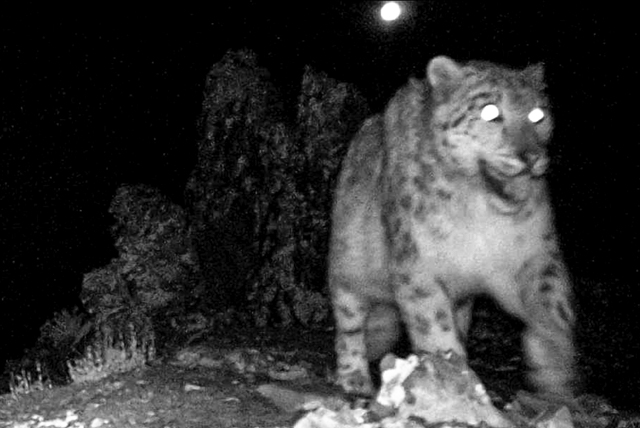
What is their prey and how abundant is it? Snow leopards prey on members of the Bovid subfamily group Caprinae, also known as the “goat-antelopes.” This group contains sheep, goats, mountain sheep like our bighorns, and mountain goats. In snow leopard country, these caprinae species consist of blue sheep, urial, ibex and argali sheep. Their abundance ranges from good numbers in protected regions where there is limited or no grazing by domestic livestock and hunting/poaching, to areas where these prey species are extinct. Where our snow leopard expeditions run, prey is abundant enough to sustain healthy numbers of snow leopards.
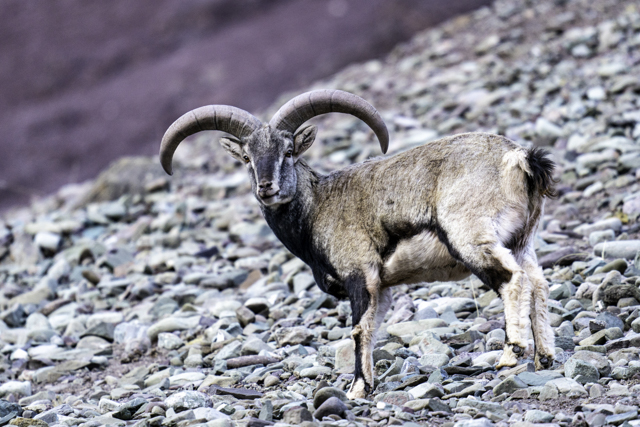
How do they find food in such harsh environment? Snow leopards travel at the very top ridges of their habitat, using their amazing vision to locate herds of blue sheep ad other prey species. They then plan and implement a stalk on their prey utilizing their incredible camouflage, and skills. When they sneak close enough, they attack their prey from above.
What altitude are you at for spotting them? In the Himalayas, Snow leopards are inaccessible in the summer, as they stay well above 15,000 feet (4500 meters) to possibly 20,000 feet. From November -April they are found in the 11-15,000 foot range, as their prey moves lower, and we can find them easily. In Mongolia snow leopards live in low elevation desert steppe areas, but they are always more difficult to find because they live in a horizontal, flatter landscape, instead of a high ridge and valley structure where snow leopard spotters can see vast amounts of habitat from a static location.
This looks like a really barren area, what do they eat and is there enough food to sustain them? This area is a high desert, but, if not overgrazed by domestic goats, sheep and yaks, there is ample forage for the snow leopard’s prey, such as blue sheep, ibex, urial and argali sheep, all which are similar to North American bighorn sheep.
Do they have any predators? Other than humans, snow leopards do not have predators, but they can be displaced or get into confrontations with packs of wolves. Wolves can pose a threat to cubs.
Has the increased traffic of climbers in the mountains had an effect on the leopards? In the areas where snow leopard tourism takes place there isn’t very much mountaineering to my knowledge. I haven’t heard that this is a concern in any parts of their range. There would be no way to know, because if you displace a snow leopard, no one would ever know, or have seen it in the first place. They are like phantoms. We should always consider the impacts of human activities in snow leopard country.
How long is a typical trip – including accilimatizing time? Trips are normally around 12 days including 2 days of acclimatizing, which involves relaxing while your body gets accustomed to the elevation.
Are snow leopards in the same genus as African leopards? Yes, they are both in the same genus, Pathera, with all of the big cats. The smaller cats are in the genus Felis. Genetically, however, as you can see below, the snow leopard’s closest relative is the tiger. All cats belong to the family Felidae.
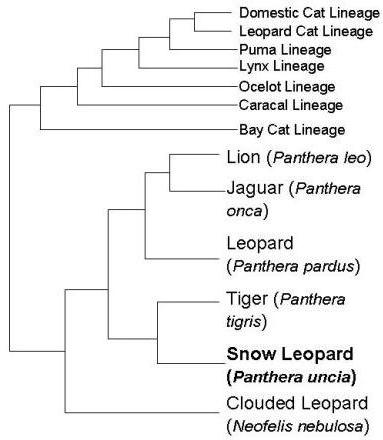
What adaptations help snow leopards deal with cold temperatures? -Snow leopards have thick fur, up to five inches thick, which consists of long guard hairs as well as a wooly undercoat, that provides insulation. They also have larger nasal cavities which allows the air to be warmed before it enters the body’s core. They also have small ears, as extremities are more vulnerable to cold. They have furry feet, which are also oversized to act as snowshoes. All of these adaptations are very similar to those of polar bears. Snow leopards use their very long tails to keep their faces warm when sleeping. On sunny days they find a south-facing slope to soak up the sun’s warmth on a hot rock.
In the game camera footage the snow leaopard looks pregnant. Do you suppose she is? Mating season for snow leopards is February/March, and cubs are born in June. As most of the clips were filmed in Feb/March the females are not pregnant enough to show a belly yet. All snow leopards can look like they have a big belly, because they have long fur on the belly to keep warm. Like all big cats, they have a large stomach so they can eat a lot from a kill at one time. When full, their bellies look very large. It is possible for some of the leopards on the summer clips from the game camera are pregnant, but a big belly is not a definitive way to tell.
Do you think that creating these corrals for the domestic animals is going to result in starvation for the snow leopards? The destruction of the habitat by the locals is probably limiting their natural prey. Great point! A snow leopard which relies on killing livestock habitually is likely going to be killed by herders. It is very easy to keep snow leopards from killing baby livestock- put them in corrals at night. If the corral isn’t not covered at the top with fencing, a snow leopard can enter and kill the entire group of animals. They get into a killing frenzy as the sheep or yaks run around in a panic. That leopard then is confronted by angry herders, and sometimes has to be either killed, or rescued by wildlife officials, as they have been known to get stuck inside the corral. Predator-proof corrals are truly the key to stopping this behavior which results in “retribution killing” by livestock owners. The next step is to put a value on snow leopard populations by limiting overgrazing by livestock, and providing an alternative source of income through tourism. During this severe disruption in the snow leopard tourism economy because of Covid-19, we have found a brilliant strategy to keep those locals employed by installing predator-proof corrals in areas that desperately need them, which we have already located. We have set up an emergency relief fund to pay for this project. Click here to donate to this program. This will be an excellent way for the local snow leopard guides and camp staff to regain some of their income by helping prevent further snow leopard/human conflict. This is the first project in a brand new organization I am involved with called https://highasiafund.org

How long do cubs stay with their mothers? They are born in June/July and stay with mom for 1.5-2 years. After that siblings often stay together for a few months.
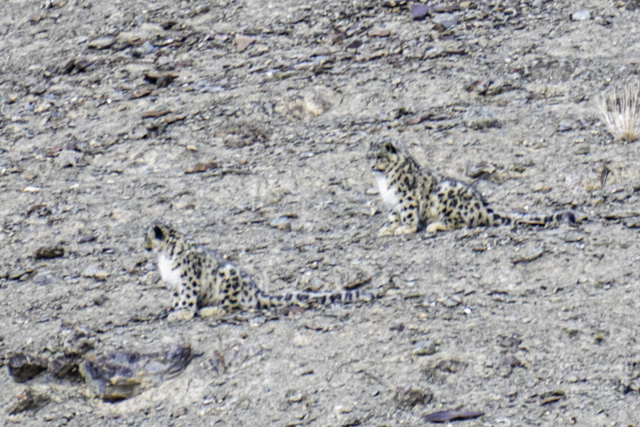
What’s the weather like where these snow leopards live? Average feet of snow? Temperatures? Snow storms or ice storms? With the exception of the outer rim of the Himalayas, which does receive deep snow, most of snow leopard habitat is a desert. There is usually a few feet of total snowfall during the winter, with more at the highest elevations. Temperatures are cold in winter. In the Indian Himalayas, were most snow leopard tourism takes place, temps range from -20 Far on the coldest nights to mid 40s during the day. In Mongolian, Chinese, and Russian snow leopard habitats temperatures are often -40 F/C. Summers across the region are hot and dry, depending on altitude.
Feel free to ask more questions in the comments below! Thank you all for your interest in snow leopard conservation!

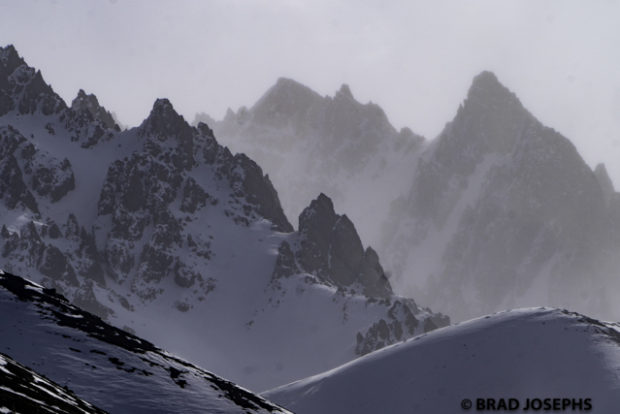

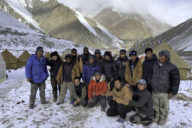
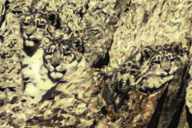
No Comments